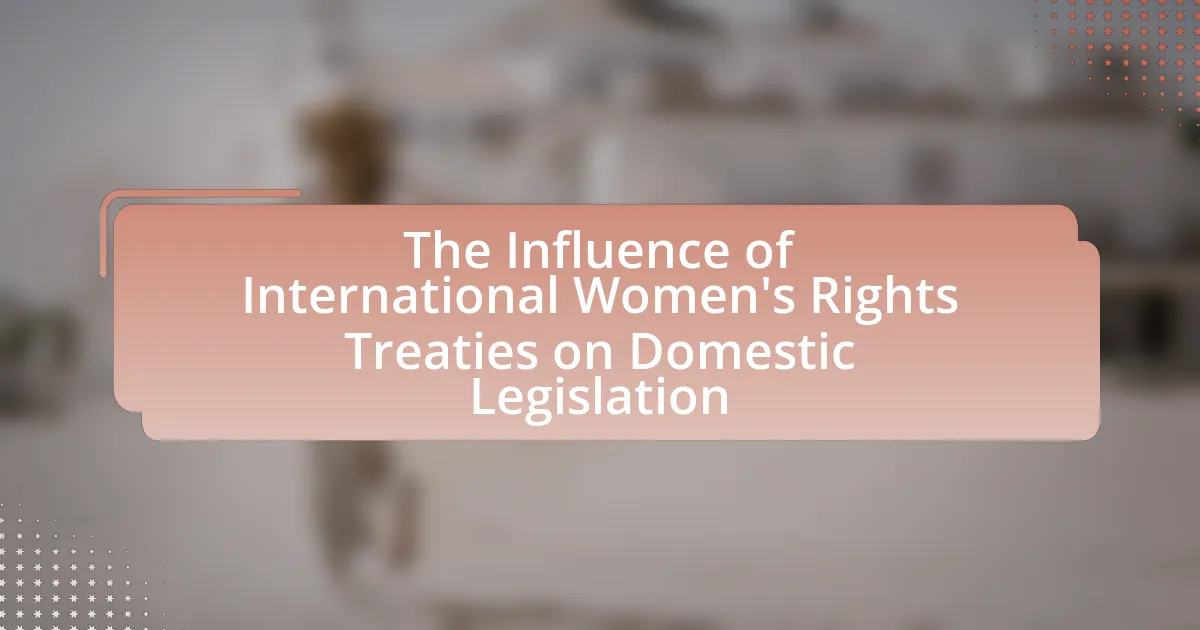International Women’s Rights Treaties are legally binding agreements designed to promote and protect women’s rights globally, with the Convention on the Elimination of All Forms of Discrimination Against Women (CEDAW) being a prominent example. These treaties establish international standards for gender equality and compel signatory countries to align their domestic laws accordingly. The article explores the impact of these treaties on women’s rights, detailing how they influence national legislation, public policy, and the mechanisms that facilitate their incorporation into domestic law. It also addresses the challenges countries face in aligning their laws with international standards and highlights the measurable outcomes of treaty implementation on women’s rights across various nations. Additionally, the article discusses criticisms and limitations of these treaties, as well as best practices for enhancing their effectiveness in promoting gender equality.
What are International Women’s Rights Treaties?
International Women’s Rights Treaties are legally binding agreements aimed at promoting and protecting women’s rights globally. These treaties, such as the Convention on the Elimination of All Forms of Discrimination Against Women (CEDAW), establish international standards for gender equality and serve as frameworks for countries to align their domestic laws with these standards. CEDAW, adopted by the United Nations in 1979, has been ratified by over 180 countries, demonstrating its widespread acceptance and influence on national legislation regarding women’s rights.
How do these treaties impact women’s rights globally?
International women’s rights treaties significantly enhance women’s rights globally by establishing legal frameworks that promote gender equality and protect against discrimination. These treaties, such as the Convention on the Elimination of All Forms of Discrimination Against Women (CEDAW), obligate signatory countries to implement policies that advance women’s rights in various sectors, including education, health, and employment. For instance, CEDAW has been instrumental in influencing national laws, leading to increased representation of women in political positions and improved access to reproductive health services in many countries. The impact is evidenced by the fact that over 180 countries have ratified CEDAW, resulting in legislative reforms that address issues like domestic violence and workplace discrimination, thereby fostering a more equitable society for women worldwide.
What are the key treaties that focus on women’s rights?
The key treaties that focus on women’s rights include the Convention on the Elimination of All Forms of Discrimination Against Women (CEDAW), the Beijing Declaration and Platform for Action, and the Convention on the Rights of the Child (CRC). CEDAW, adopted in 1979 by the United Nations General Assembly, specifically addresses discrimination against women and sets an agenda for national action to end such discrimination. The Beijing Declaration and Platform for Action, established in 1995, outlines strategic objectives and actions for advancing women’s rights globally. The CRC, adopted in 1989, emphasizes the rights of children, including girls, and promotes their well-being and development. These treaties collectively influence domestic legislation by establishing international standards that countries are encouraged to adopt and implement.
How do these treaties define women’s rights?
International women’s rights treaties define women’s rights as fundamental human rights that encompass equality, non-discrimination, and the right to participate fully in society. For instance, the Convention on the Elimination of All Forms of Discrimination Against Women (CEDAW) explicitly states that discrimination against women is a violation of human rights and emphasizes the need for states to take appropriate measures to eliminate such discrimination. Additionally, the Beijing Declaration and Platform for Action outlines specific areas of concern, including violence against women, education, and health, reinforcing the obligation of states to ensure women’s rights are protected and promoted. These treaties collectively establish a framework that obligates countries to align their domestic laws with international standards, thereby influencing national legislation to enhance women’s rights and gender equality.
Why are these treaties important for domestic legislation?
International women’s rights treaties are crucial for domestic legislation because they establish binding international standards that countries are obligated to incorporate into their national laws. These treaties, such as the Convention on the Elimination of All Forms of Discrimination Against Women (CEDAW), provide a framework for governments to address gender inequality and promote women’s rights. For instance, CEDAW has been ratified by 189 countries, influencing domestic policies by mandating legal reforms that enhance women’s access to education, healthcare, and employment opportunities. This alignment with international norms not only strengthens legal protections for women but also fosters accountability among governments to uphold these rights, thereby improving the overall status of women in society.
What role do international norms play in shaping domestic laws?
International norms significantly influence the development of domestic laws by providing a framework that countries adopt to align with global standards. These norms, often established through treaties and conventions, serve as benchmarks for legal reforms, guiding nations in creating legislation that promotes equality and protects human rights. For instance, the Convention on the Elimination of All Forms of Discrimination Against Women (CEDAW) has prompted numerous countries to amend their laws to eliminate gender discrimination, demonstrating how international commitments can lead to tangible changes in domestic legal systems.
How do treaties influence public policy regarding women’s rights?
Treaties influence public policy regarding women’s rights by establishing international legal standards that countries are obligated to implement domestically. For instance, the Convention on the Elimination of All Forms of Discrimination Against Women (CEDAW) requires signatory nations to adopt measures that promote gender equality and protect women’s rights. This treaty has led to significant legislative changes in various countries, such as the introduction of laws addressing domestic violence and workplace discrimination. Furthermore, compliance with such treaties is often monitored by international bodies, which can pressure governments to align their policies with international norms, thereby reinforcing the legal framework for women’s rights at the national level.
How do International Women’s Rights Treaties influence Domestic Legislation?
International Women’s Rights Treaties influence Domestic Legislation by establishing legal standards and frameworks that countries are encouraged to adopt. These treaties, such as the Convention on the Elimination of All Forms of Discrimination Against Women (CEDAW), provide guidelines that compel nations to align their laws with international norms regarding gender equality and women’s rights. For instance, after ratifying CEDAW, many countries have enacted laws to address domestic violence, workplace discrimination, and reproductive rights, reflecting the treaty’s principles. The impact is evident in legislative reforms; for example, countries like Rwanda and Mexico have significantly improved women’s representation in government and legal protections due to their commitments under international treaties.
What mechanisms facilitate the incorporation of treaties into domestic law?
The mechanisms that facilitate the incorporation of treaties into domestic law include legislative enactment, constitutional provisions, and judicial interpretation. Legislative enactment involves the formal adoption of treaty provisions through national legislation, which is often required for treaties to have legal effect domestically. Constitutional provisions may stipulate that ratified treaties automatically become part of domestic law or require specific legislative action for implementation. Judicial interpretation plays a role when courts interpret domestic laws in light of international treaty obligations, ensuring that domestic law aligns with international commitments. These mechanisms are essential for ensuring that international women’s rights treaties are effectively integrated into national legal frameworks, thereby influencing domestic legislation related to women’s rights.
How do countries ratify and implement these treaties?
Countries ratify and implement treaties through a formal legislative process that typically involves signing, ratification, and domestic incorporation. Initially, a country signs a treaty, indicating its intention to be bound by its terms. Following this, the treaty must be ratified, which often requires approval from the national legislature or parliament, depending on the country’s legal framework. For instance, the United States requires a two-thirds Senate majority for ratification, while other countries may have different procedures.
Once ratified, countries must implement the treaty into domestic law, which can involve enacting new legislation or amending existing laws to align with the treaty’s provisions. For example, the Convention on the Elimination of All Forms of Discrimination Against Women (CEDAW) has led many countries to revise their laws to enhance women’s rights and eliminate discrimination. This process ensures that international commitments translate into actionable legal frameworks within the country, thereby influencing domestic legislation effectively.
What challenges do countries face in aligning domestic laws with international treaties?
Countries face significant challenges in aligning domestic laws with international treaties, primarily due to legal, cultural, and political factors. Legal discrepancies arise when national laws conflict with treaty obligations, making it difficult for countries to implement necessary changes. Cultural resistance often stems from traditional norms and values that may contradict the principles outlined in international treaties, particularly regarding women’s rights. Politically, the lack of political will or support can hinder the adoption of reforms needed to comply with international standards. For instance, in many countries, legislative processes can be slow and cumbersome, delaying the alignment of laws with treaties. These challenges illustrate the complexities involved in harmonizing domestic legislation with international commitments, particularly in the context of women’s rights.
What are the effects of treaty implementation on women’s rights in various countries?
Treaty implementation significantly enhances women’s rights in various countries by establishing legal frameworks that promote gender equality and protect against discrimination. For instance, the Convention on the Elimination of All Forms of Discrimination Against Women (CEDAW) has led to legislative reforms in countries like Rwanda, where women now hold over 60% of parliamentary seats, a direct result of commitments made under the treaty. Additionally, countries such as Sweden and Canada have seen improvements in domestic violence laws and reproductive rights following their ratification of international treaties. These changes demonstrate that treaty implementation can lead to tangible advancements in women’s rights, as evidenced by increased political representation and legal protections in multiple nations.
How have specific countries improved women’s rights through treaty adherence?
Countries have improved women’s rights through treaty adherence by implementing legal reforms that align with international standards. For example, Sweden’s adherence to the Convention on the Elimination of All Forms of Discrimination Against Women (CEDAW) has led to comprehensive legislation promoting gender equality in various sectors, including employment and education. Similarly, Rwanda’s commitment to CEDAW has resulted in a significant increase in women’s representation in government, with women holding over 60% of parliamentary seats, the highest in the world. These changes demonstrate how treaty obligations can drive national policies that enhance women’s rights and promote gender equality.
What are the measurable outcomes of treaty influence on domestic legislation?
The measurable outcomes of treaty influence on domestic legislation include the adoption of laws that align with international standards, increased legal protections for women’s rights, and enhanced enforcement mechanisms. For instance, the Convention on the Elimination of All Forms of Discrimination Against Women (CEDAW) has led to countries amending their legal frameworks to prohibit gender-based discrimination, as evidenced by the implementation of laws in nations like Rwanda, which adopted a gender parity law following its ratification of CEDAW. Additionally, measurable outcomes can be seen in the increase of women’s representation in political and legal processes, as countries that ratify international treaties often commit to promoting gender equality in governance, leading to a measurable rise in women’s participation in legislative bodies.
What are the criticisms and limitations of International Women’s Rights Treaties?
International Women’s Rights Treaties face criticisms and limitations primarily due to their lack of enforcement mechanisms and cultural specificity. Critics argue that these treaties often rely on voluntary compliance from states, which can lead to inconsistent implementation and enforcement. For instance, the Convention on the Elimination of All Forms of Discrimination Against Women (CEDAW) has been ratified by many countries, yet compliance varies significantly, with some nations failing to adopt necessary domestic laws. Additionally, the treaties may not adequately address the diverse cultural contexts of women’s rights, leading to resistance in certain regions where local customs conflict with international standards. This cultural disconnect can hinder the effectiveness of the treaties in promoting gender equality globally.
What are the common criticisms of these treaties?
Common criticisms of international women’s rights treaties include their lack of enforcement mechanisms, which often leads to non-compliance by signatory states. Critics argue that without binding obligations, countries can ratify treaties without making meaningful changes to domestic laws or practices. Additionally, some argue that these treaties may not adequately address the cultural and social contexts of different countries, leading to ineffective implementation. For instance, the Convention on the Elimination of All Forms of Discrimination Against Women (CEDAW) has faced criticism for being perceived as a Western imposition, which can hinder its acceptance in non-Western societies. Furthermore, the treaties are often seen as overly broad, lacking specificity in terms of actionable steps for states, which can result in varied interpretations and inconsistent application across different jurisdictions.
How do critics argue that treaties may fall short in practice?
Critics argue that treaties may fall short in practice due to issues such as lack of enforcement mechanisms and varying levels of commitment among signatory states. For instance, while international treaties like the Convention on the Elimination of All Forms of Discrimination Against Women (CEDAW) set standards for women’s rights, many countries fail to implement these standards effectively due to insufficient political will or resources. Additionally, critics highlight that domestic legal systems may not align with international obligations, leading to gaps in protection for women’s rights. This disconnect is evident in cases where national laws contradict treaty provisions, undermining the treaties’ intended impact.
What are the limitations in enforcement of these treaties?
The limitations in enforcement of international women’s rights treaties include lack of binding authority, insufficient monitoring mechanisms, and varying levels of commitment from member states. These treaties often rely on voluntary compliance, which can lead to inconsistent implementation across different countries. For instance, the Convention on the Elimination of All Forms of Discrimination Against Women (CEDAW) lacks enforcement power, meaning that states can choose not to adhere to its provisions without facing significant consequences. Additionally, the absence of robust accountability measures makes it difficult to address violations effectively, as seen in cases where countries fail to report on their progress or take necessary actions to uphold women’s rights.
How can the effectiveness of these treaties be improved?
The effectiveness of international women’s rights treaties can be improved by enhancing monitoring mechanisms and increasing the involvement of local stakeholders. Strengthening monitoring mechanisms ensures compliance and accountability, as evidenced by the success of the Convention on the Elimination of All Forms of Discrimination Against Women (CEDAW), which has led to significant legislative changes in countries that actively report and engage with the treaty’s provisions. Additionally, involving local stakeholders, such as women’s organizations and community leaders, fosters grassroots support and ensures that the treaties address specific cultural and societal needs, as demonstrated by initiatives in countries like Rwanda, where local engagement has led to improved gender equality outcomes.
What best practices can enhance treaty implementation in domestic legislation?
Best practices that can enhance treaty implementation in domestic legislation include aligning national laws with international standards, ensuring stakeholder engagement, and establishing monitoring mechanisms. Aligning national laws with international standards ensures that domestic legislation reflects the commitments made under treaties, which is crucial for effective implementation. Engaging stakeholders, including civil society organizations and affected communities, fosters transparency and accountability, thereby increasing public support for the treaty’s objectives. Establishing monitoring mechanisms, such as regular reporting and evaluation processes, allows for the assessment of compliance and effectiveness, facilitating necessary adjustments to legislation. These practices are supported by the findings of the United Nations Development Programme, which emphasizes the importance of legal alignment and stakeholder involvement in successful treaty implementation.
How can civil society contribute to the enforcement of women’s rights treaties?
Civil society can contribute to the enforcement of women’s rights treaties by actively monitoring government compliance and advocating for accountability. Organizations such as NGOs and grassroots movements play a crucial role in raising awareness about women’s rights issues, documenting violations, and providing legal support to affected individuals. For instance, the Women’s Rights Advocacy Network has successfully pressured governments to align national laws with international treaties, demonstrating the effectiveness of civil society in influencing policy changes. Additionally, civil society can engage in capacity-building initiatives, empowering women to assert their rights and participate in decision-making processes, thereby reinforcing the implementation of these treaties at the local level.
What practical steps can countries take to align domestic legislation with international women’s rights treaties?
Countries can align domestic legislation with international women’s rights treaties by conducting comprehensive legal reviews to identify gaps between national laws and treaty obligations. This process involves assessing existing laws against the standards set by treaties such as the Convention on the Elimination of All Forms of Discrimination Against Women (CEDAW). Following the review, countries should amend or enact laws that promote gender equality, ensuring that legal frameworks reflect the principles of non-discrimination and equal rights. Additionally, countries can establish mechanisms for monitoring and reporting on compliance with international standards, which can include creating national action plans that outline specific goals and timelines for implementation. Engaging civil society organizations in the legislative process can also enhance accountability and ensure that women’s voices are included in law-making. These steps are supported by the findings of the United Nations, which emphasize the importance of aligning national legislation with international commitments to effectively promote women’s rights.


